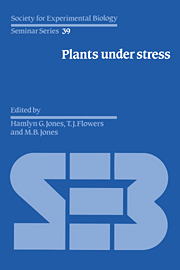Book contents
- Frontmatter
- Contents
- Contributors
- Preface
- 1 Introduction: some terminology and common mechanisms
- 2 The impact of environmental stresses on ecosystems
- 3 Whole-plant responses to stress in natural and agricultural systems
- 4 Photosynthesis and gas exchange
- 5 Regulation of growth and development of plants growing with a restricted supply of water
- 6 Stresses, membranes and cell walls
- 7 Desiccation injury, anhydrobiosis and survival
- 8 Molecular biology: application to studies of stress tolerance
- 9 Environmental control of gene expression and stress proteins in plants
- 10 Plant tissue and protoplast culture: applications to stress physiology and biochemistry
- 11 Breeding methods for drought resistance
- 12 Selection for physiological characters – examples from breeding for salt tolerance
- 13 Prospects for improving crop production in stressful environments
- Index
7 - Desiccation injury, anhydrobiosis and survival
Published online by Cambridge University Press: 16 March 2010
- Frontmatter
- Contents
- Contributors
- Preface
- 1 Introduction: some terminology and common mechanisms
- 2 The impact of environmental stresses on ecosystems
- 3 Whole-plant responses to stress in natural and agricultural systems
- 4 Photosynthesis and gas exchange
- 5 Regulation of growth and development of plants growing with a restricted supply of water
- 6 Stresses, membranes and cell walls
- 7 Desiccation injury, anhydrobiosis and survival
- 8 Molecular biology: application to studies of stress tolerance
- 9 Environmental control of gene expression and stress proteins in plants
- 10 Plant tissue and protoplast culture: applications to stress physiology and biochemistry
- 11 Breeding methods for drought resistance
- 12 Selection for physiological characters – examples from breeding for salt tolerance
- 13 Prospects for improving crop production in stressful environments
- Index
Summary
Introduction
Water is, of course, essential for plant growth, but one of the themes of this chapter is that it may not be necessary for plant survival. Although most agronomically important plants are very sensitive to internal water deficits, the majority of plants at some stage of their life cycle are tolerant of desiccation. Few of these have vegetative parts which are desiccation tolerant, but the survival of even so-called drought-evading species, such as the ephemeral desert annuals, rests on the tolerance of their seeds to desiccation.
Desiccation tolerant species may exhibit little or no metabolic activity depending upon the extent of dehydration. In this anhydrobiotic or ametabolic state we are concerned not with metabolic perturbation but with the stability of organelles, membranes and macromolecules in a dehydrated state. However, in the initial period of rehydration, the passage to a metabolically active state poses particular problems if metabolic ‘mayhem’ is to be avoided.
Knowledge of how organisms avoid irreversible damage from dehydration is obviously of importance in the preservation of seeds and germplasm. It may also further our understanding of the role played by water in maintaining structural and functional integrity of membranes and macromolecules. The controlled metabolic shutdown which occurs as organisms pass into a state of anhydrobiosis may provide valuable insights into the functional significance of the metabolic responses to water deficits in mesophytes.
Desiccation tolerant plants
There are representatives of desiccation tolerant species amongst all of the major plant divisions. The water content of many bacterial and fungal spores is low (<25%) and they exhibit great tolerance of desiccation (see Ross & Billing, 1957; Bradbury et al, 1981).
- Type
- Chapter
- Information
- Plants under StressBiochemistry, Physiology and Ecology and their Application to Plant Improvement, pp. 115 - 130Publisher: Cambridge University PressPrint publication year: 1989
- 9
- Cited by



